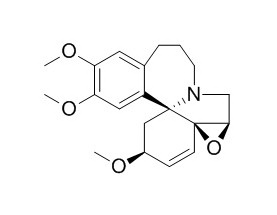Wilsonine
Standard reference
Inquire / Order:
manager@chemfaces.com
Technical Inquiries:
service@chemfaces.com
Tel:
+86-27-84237783
Fax:
+86-27-84254680
Address:
1 Building, No. 83, CheCheng Rd., Wuhan Economic and Technological Development Zone, Wuhan, Hubei 430056, PRC
Providing storage is as stated on the product vial and the vial is kept tightly sealed, the product can be stored for up to
24 months(2-8C).
Wherever possible, you should prepare and use solutions on the same day. However, if you need to make up stock solutions in advance, we recommend that you store the solution as aliquots in tightly sealed vials at -20C. Generally, these will be useable for up to two weeks. Before use, and prior to opening the vial we recommend that you allow your product to equilibrate to room temperature for at least 1 hour.
Need more advice on solubility, usage and handling? Please email to: service@chemfaces.com
The packaging of the product may have turned upside down during transportation, resulting in the natural compounds adhering to the neck or cap of the vial. take the vial out of its packaging and gently shake to let the compounds fall to the bottom of the vial. for liquid products, centrifuge at 200-500 RPM to gather the liquid at the bottom of the vial. try to avoid loss or contamination during handling.
Biotechnology and Bioprocess Engineering2024, 29:1048-1060.
QASCF2022, 14(4).
Food Chem.2016, 191:81-90
Mol Med Rep.2022, 26(4):299.
J Ethnopharmacol.2020, 269:113752.
Nat Commun.2023 Dec 20;14(1):8457.
Pharmaceuticals (Basel).2022, 15(5):591.
Bioorg Chem.2024, 145:107184.
Journal of Medical Sciences2024, 44(5):p 222-227.
Microb Pathog.2019, 131:128-134
Related and Featured Products
J Chromatogr A. 2009 May 29;1216(22):4663-7.
Completed preparative separation of alkaloids from Cephaltaxus fortunine by step-pH-gradient high-speed counter-current chromatography.[Pubmed:
19393155]
Cephalotaxine-type alkaloids are the anti-cancer components in twigs, leaves, roots and seeds of Cephalotaxus fortunine. It is very important to use the limited resource by finding an efficient purification technology of the alkaloids.
METHODS AND RESULTS:
Separation of cephalotaxine-type alkaloids in Cephalotaxus fortunine by step-pH-gradient high-speed counter-current chromatography (step-pH-gradient HSCCC) was studied in this paper. The step-pH-gradient HSCCC was performed on a HSCCC instrument equipped with a 400-mL column, using the upper phase of ethyl acetate-n-hexane-water, with added 0.01% trifluoroacetic acid (TFA) as stationary phase, and the lower phase of ethyl acetate-n-hexane-water, with added 2% NH(4)OH, 0.2% NH(4)OH and 0.05% TFA as mobile phase. For each separation, 800mg of extract of cephalotaxine-type alkaloids was separated to yield 9.3mg of drupacine, 15.9mg of Wilsonine, 130.4mg of cephalotaxine, 64.8mg of epi-Wilsonine, 12.8mg of fortunine and 35.6mg of acetylcephalotaxine with purities 81.2%, 85.7%, 95.3%, 97.5%, 89.1% and 96.2%, respectively. The recovery of each alkaloid was more than 90%.
CONCLUSIONS:
The structures of the six alkaloids were identified by electrospray ionization mass spectrum (ESI-MS) and (1)H and (13)C NMR.
Phytochemistry,1983,22(1):251–253.
Fortuneine, a homoerythrina alkaloid from cephalotaxus fortunei.[Reference:
WebLink]
METHODS AND RESULTS:
Examination of the weakly basic fraction of the twigs and leaves of Cephalotaxus fortunei, a plant native to China, has resulted in the isolation and characterization of epiWilsonine, Wilsonine and a new alkaloid named fortuneine. The structure of fortuneine was deduced by spectral and chemical means. In addition, epifortuneine was prepared and spectral data collected.



